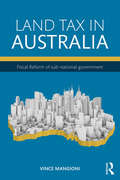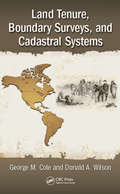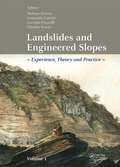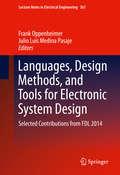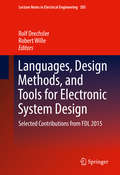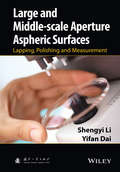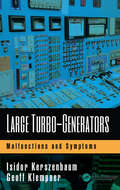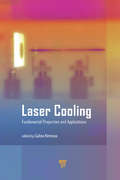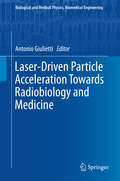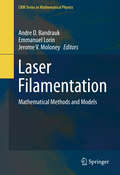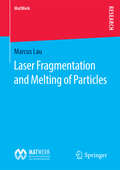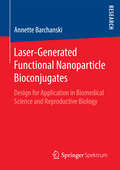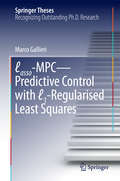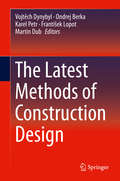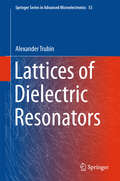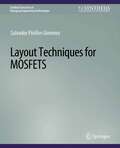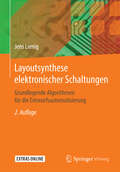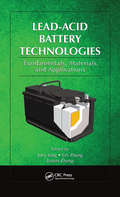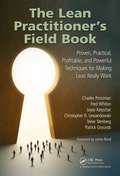- Table View
- List View
Land Tax in Australia: Fiscal reform of sub-national government
by Vince MangioniLand Tax in Australia demonstrates how land tax operates and is administered across State and local governments in Australia. International expert Vincent Mangioni reviews the current status and emerging trends in these taxes in Australia and compares them with the UK, USA, Canada, Denmark and New Zealand. Using substantial original research, the author sets out what Australia must do through practice and policy to reform and bring this tax into the 21st Century. The need for fiscal reform and strengthening the finances of Australia’s sub-national government is long overdue. These reforms aim to minimise the taxpayer revolts encountered in previous attempts at land tax reform, while improving tax effort in line with other advanced OECD countries. This book provides an essential resource for all property professionals working in development, valuation, law, investment, as well as accountants, tax economists and government administrators. It is highly recommended for students on property, taxation, legal and social science courses.
Land Tenure, Boundary Surveys, and Cadastral Systems
by George M. Cole Donald A. WilsonLand is important to all aspects of human life and has a key role in the economic well-being of society therefore, land tenure, land ownership, and real property law is a critical part of any developed nation. Together, the processes of how land parcels are held; how they are defined, measured, and described to allow economic transactions; how they are marked to allow their use and defense; and how they are legally protected have allowed for the orderly possession and use of land. In doing so, these processes have also provided the basis for the advanced economy of most developed nations. Very often, these processes—land tenure, boundary surveying, and cadastral systems—are considered separately. They are very much interrelated, and none of these processes may be completely understood without an understanding of the others. Land Tenure, Boundary Surveys, and Cadastral Systems provides an introduction to land tenure, cadastral systems, and boundary surveying, including an understanding of the interrelationship of these areas and their role in land tenure and real property law. This is especially true considering the advent of georeferenced cadastral maps reflecting the location of land parcels relative to many other components of the physical and legal infrastructure. Although intended as a basic text for college-level surveying courses, this book should also be of significant value to cadastral mappers, real property attorneys, land title professionals, and others involved with land transactions.
Land Tenure, Boundary Surveys, and Cadastral Systems
by George M. Cole Donald A. WilsonLand is important to all aspects of human life and has a key role in the economic well-being of society therefore, land tenure, land ownership, and real property law is a critical part of any developed nation. Together, the processes of how land parcels are held; how they are defined, measured, and described to allow economic transactions; how they are marked to allow their use and defense; and how they are legally protected have allowed for the orderly possession and use of land. In doing so, these processes have also provided the basis for the advanced economy of most developed nations. Very often, these processes—land tenure, boundary surveying, and cadastral systems—are considered separately. They are very much interrelated, and none of these processes may be completely understood without an understanding of the others. Land Tenure, Boundary Surveys, and Cadastral Systems provides an introduction to land tenure, cadastral systems, and boundary surveying, including an understanding of the interrelationship of these areas and their role in land tenure and real property law. This is especially true considering the advent of georeferenced cadastral maps reflecting the location of land parcels relative to many other components of the physical and legal infrastructure. Although intended as a basic text for college-level surveying courses, this book should also be of significant value to cadastral mappers, real property attorneys, land title professionals, and others involved with land transactions.
Landslides and Engineered Slopes. Experience, Theory and Practice: Proceedings of the 12th International Symposium on Landslides (Napoli, Italy, 12-19 June 2016)
by Stefano Aversa Leonardo Cascini Luciano Picarelli Claudio ScaviaLandslides and Engineered Slopes. Experience, Theory and Practice contains the invited lectures and all papers presented at the 12th International Symposium on Landslides, (Naples, Italy, 12-19 June 2016). The book aims to emphasize the relationship between landslides and other natural hazards. Hence, three of the main sessions focus on Volcanic-induced landslides, Earthquake-induced landslides and Weather-induced landslides respectively, while the fourth main session deals with Human-induced landslides. Some papers presented in a special session devoted to "Subareal and submarine landslide processes and hazard” and in a “Young Session” complete the books. Landslides and Engineered Slopes. Experience, Theory and Practice underlines the importance of the classic approach of modern science, which moves from experience to theory, as the basic instrument to study landslides. Experience is the key to understand the natural phenomena focusing on all the factors that play a major role. Theory is the instrument to manage the data provided by experience following a mathematical approach; this allows not only to clarify the nature and the deep causes of phenomena but mostly, to predict future and, if required, manage similar events. Practical benefits from the results of theory to protect people and man-made works. Landslides and Engineered Slopes. Experience, Theory and Practice is useful to scientists and practitioners working in the areas of rock and soil mechanics, geotechnical engineering, engineering geology and geology.
Landslides and Engineered Slopes. Experience, Theory and Practice: Proceedings of the 12th International Symposium on Landslides (Napoli, Italy, 12-19 June 2016)
by Stefano Aversa, Leonardo Cascini, Luciano Picarelli and Claudio ScaviaLandslides and Engineered Slopes. Experience, Theory and Practice contains the invited lectures and all papers presented at the 12th International Symposium on Landslides, (Naples, Italy, 12-19 June 2016). The book aims to emphasize the relationship between landslides and other natural hazards. Hence, three of the main sessions focus on Volcanic-induced landslides, Earthquake-induced landslides and Weather-induced landslides respectively, while the fourth main session deals with Human-induced landslides. Some papers presented in a special session devoted to "Subareal and submarine landslide processes and hazard” and in a “Young Session” complete the books. Landslides and Engineered Slopes. Experience, Theory and Practice underlines the importance of the classic approach of modern science, which moves from experience to theory, as the basic instrument to study landslides. Experience is the key to understand the natural phenomena focusing on all the factors that play a major role. Theory is the instrument to manage the data provided by experience following a mathematical approach; this allows not only to clarify the nature and the deep causes of phenomena but mostly, to predict future and, if required, manage similar events. Practical benefits from the results of theory to protect people and man-made works. Landslides and Engineered Slopes. Experience, Theory and Practice is useful to scientists and practitioners working in the areas of rock and soil mechanics, geotechnical engineering, engineering geology and geology.
Languages, Design Methods, and Tools for Electronic System Design: Selected Contributions from FDL 2014 (Lecture Notes in Electrical Engineering #361)
by Frank Oppenheimer Julio Luis Medina PasajeThis book brings together a selection of the best papers from the seventeenth edition of the Forum on specification and Design Languages Conference (FDL), which took place on October 14-16, 2014, in Munich, Germany. FDL is a well-established international forum devoted to dissemination of research results, practical experiences and new ideas in the application of specification, design and verification languages to the design, modeling and verification of integrated circuits, complex hardware/software embedded systems, and mixed-technology systems.
Languages, Design Methods, and Tools for Electronic System Design: Selected Contributions from FDL 2015 (Lecture Notes in Electrical Engineering #385)
by Rolf Drechsler Robert WilleThis book brings together a selection of the best papers from the eighteenth edition of the Forum on specification and Design Languages Conference (FDL), which took place on September 14-16, 2015, in Barcelona, Spain. FDL is a well-established international forum devoted to dissemination of research results, practical experiences and new ideas in the application of specification, design and verification languages to the design, modeling and verification of integrated circuits, complex hardware/software embedded systems, and mixed-technology systems.
Large and Middle-scale Aperture Aspheric Surfaces: Lapping, Polishing and Measurement
by Shengyi Li Yifan DaiA complete all-in-one reference to aspheric fabrication and testing for optical applications This book provides a detailed introduction to the manufacturing and measurement technologies in aspheric fabrication. For each technology, both basic theory and practical applications are introduced. The book consists of two parts. In the first part, the basic principles of manufacturing technology for aspheric surfaces and key theory for deterministic subaperture polishing of aspheric surfaces are discussed. Then key techniques for high precision figuring such as CCOS with small polishing pad, IBF and MRF, are introduced, including the basic principles, theories and applications, mathematical modeling methods, machine design and process parameter selection. It also includes engineering practices and experimental results, based on the three kinds of polishing tools (CCOS, IBF and MRF) developed by the author’s research team. In the second part, basic principles of measurement and some typical examples for large and middle-scale aspheric surfaces are discussed. Then, according to the demands of low cost, high accuracy and in-situ measurement methods in the manufacturing process, three kinds of technologies are introduced, such as the Cartesian and swing-arm polar coordinate profilometer, the sub-aperture stitching interferometer and the phase retrieval method based on diffraction principle. Some key techniques are also discussed, including the basic principles, mathematical modeling methods, machine design and process parameter selection, as well as engineering practices and experimental results. Finally, the team’s research results about subsurface quality measurement and guarantee methods are also described. This book can be used as a reference for scientists and technologists working in optical manufacturing, ultra-precision machining, precision instruments and measurement, and other precision engineering fields. A complete all-in-one reference to aspheric fabrication and testing for optical applications Presents the latest research findings from the author’s internationally recognized leading team who are at the cutting edge of the technology Brings together surface processing and measurement in one complete volume, discussing problems and solutions Guides the reader from an introductory overview through to more advanced and sophisticated techniques of metrology and manufacturing, suitable for the student and the industry professional
Large and Middle-scale Aperture Aspheric Surfaces: Lapping, Polishing and Measurement
by Shengyi Li Yifan DaiA complete all-in-one reference to aspheric fabrication and testing for optical applications This book provides a detailed introduction to the manufacturing and measurement technologies in aspheric fabrication. For each technology, both basic theory and practical applications are introduced. The book consists of two parts. In the first part, the basic principles of manufacturing technology for aspheric surfaces and key theory for deterministic subaperture polishing of aspheric surfaces are discussed. Then key techniques for high precision figuring such as CCOS with small polishing pad, IBF and MRF, are introduced, including the basic principles, theories and applications, mathematical modeling methods, machine design and process parameter selection. It also includes engineering practices and experimental results, based on the three kinds of polishing tools (CCOS, IBF and MRF) developed by the author’s research team. In the second part, basic principles of measurement and some typical examples for large and middle-scale aspheric surfaces are discussed. Then, according to the demands of low cost, high accuracy and in-situ measurement methods in the manufacturing process, three kinds of technologies are introduced, such as the Cartesian and swing-arm polar coordinate profilometer, the sub-aperture stitching interferometer and the phase retrieval method based on diffraction principle. Some key techniques are also discussed, including the basic principles, mathematical modeling methods, machine design and process parameter selection, as well as engineering practices and experimental results. Finally, the team’s research results about subsurface quality measurement and guarantee methods are also described. This book can be used as a reference for scientists and technologists working in optical manufacturing, ultra-precision machining, precision instruments and measurement, and other precision engineering fields. A complete all-in-one reference to aspheric fabrication and testing for optical applications Presents the latest research findings from the author’s internationally recognized leading team who are at the cutting edge of the technology Brings together surface processing and measurement in one complete volume, discussing problems and solutions Guides the reader from an introductory overview through to more advanced and sophisticated techniques of metrology and manufacturing, suitable for the student and the industry professional
Large Turbo-Generators: Malfunctions and Symptoms
by Isidor Kerszenbaum Geoff KlempnerThis book presents a comprehensive, ordered relationship between malfunctions and symptoms occurring in large turbogenerators. With this book, the operator and/or engineer in a generating station could identify underlying causes of a developing component degradation or a failure quicker, which could potentially save both time and money and reduce the trial-and-error troubleshooting process. Large turbogenerators are the most important source of electricity. They can be found in thousands of power stations in every country. Forced outages, failures and degradation of these very expensive machines have an enormous aggregate cost to society. As such, any tool that can ameliorate loss of production by shaving time from troubleshooting activities, and avoiding unnecessary costs by detecting and promptly responding to component degradation, represents a step forward.
Large Turbo-Generators: Malfunctions and Symptoms
by Isidor Kerszenbaum Geoff KlempnerThis book presents a comprehensive, ordered relationship between malfunctions and symptoms occurring in large turbogenerators. With this book, the operator and/or engineer in a generating station could identify underlying causes of a developing component degradation or a failure quicker, which could potentially save both time and money and reduce the trial-and-error troubleshooting process. Large turbogenerators are the most important source of electricity. They can be found in thousands of power stations in every country. Forced outages, failures and degradation of these very expensive machines have an enormous aggregate cost to society. As such, any tool that can ameliorate loss of production by shaving time from troubleshooting activities, and avoiding unnecessary costs by detecting and promptly responding to component degradation, represents a step forward.
Laser Cooling: Fundamental Properties and Applications
by Galina NemovaIn the recent decades, laser cooling or optical refrigeration—a physical process by which a system loses its thermal energy as a result of interaction with laser light—has garnered a great deal of scientific interest due to the importance of its applications. Optical solid-state coolers are one such application. They are free from liquids as well as moving parts that generate vibrations and introduce noise to sensors and other devices. They are based on reliable laser diode pump systems. Laser cooling can also be used to mitigate heat generation in high-power lasers. This book compiles and details cutting-edge research in laser cooling done by various scientific teams all over the world that are currently revolutionizing optical refrigerating technology. It includes recent results on laser cooling by redistribution of radiation in dense gas mixtures, three conceptually different approaches to laser cooling of solids such as cooling with anti-Stokes fluorescence, Brillouin cooling, and Raman cooling. It also discusses crystal growth and glass production for laser cooling applications. This book will appeal to anyone involved in laser physics, solid-state physics, low-temperature physics or cryogenics, materials research, development of temperature sensors, or infrared detectors.
Laser Cooling: Fundamental Properties and Applications
by Galina NemovaIn the recent decades, laser cooling or optical refrigeration—a physical process by which a system loses its thermal energy as a result of interaction with laser light—has garnered a great deal of scientific interest due to the importance of its applications. Optical solid-state coolers are one such application. They are free from liquids as well as moving parts that generate vibrations and introduce noise to sensors and other devices. They are based on reliable laser diode pump systems. Laser cooling can also be used to mitigate heat generation in high-power lasers. This book compiles and details cutting-edge research in laser cooling done by various scientific teams all over the world that are currently revolutionizing optical refrigerating technology. It includes recent results on laser cooling by redistribution of radiation in dense gas mixtures, three conceptually different approaches to laser cooling of solids such as cooling with anti-Stokes fluorescence, Brillouin cooling, and Raman cooling. It also discusses crystal growth and glass production for laser cooling applications. This book will appeal to anyone involved in laser physics, solid-state physics, low-temperature physics or cryogenics, materials research, development of temperature sensors, or infrared detectors.
Laser-Driven Particle Acceleration Towards Radiobiology and Medicine (Biological and Medical Physics, Biomedical Engineering)
by Antonio GiuliettiThis book deals with the new method of laser-driven acceleration for application to radiation biophysics and medicine. It provides multidisciplinary contributions from world leading scientist in order to assess the state of the art of innovative tools for radiation biology research and medical applications of ionizing radiation. The book contains insightful contributions on highly topical aspects of spatio-temporal radiation biophysics, evolving over several orders of magnitude, typically from femtosecond and sub-micrometer scales. Particular attention is devoted to the emerging technology of laser-driven particle accelerators and their application to spatio-temporal radiation biology and medical physics, customization of non-conventional and selective radiotherapy and optimized radioprotection protocols.
Laser Filamentation: Mathematical Methods and Models (CRM Series in Mathematical Physics)
by Andre D. Bandrauk Emmanuel Lorin Jerome V. MoloneyThis book is focused on the nonlinear theoretical and mathematical problems associated with ultrafast intense laser pulse propagation in gases and in particular, in air. With the aim of understanding the physics of filamentation in gases, solids, the atmosphere, and even biological tissue, specialists in nonlinear optics and filamentation from both physics and mathematics attempt to rigorously derive and analyze relevant non-perturbative models. Modern laser technology allows the generation of ultrafast (few cycle) laser pulses, with intensities exceeding the internal electric field in atoms and molecules (E=5x109 V/cm or intensity I = 3.5 x 1016 Watts/cm2 ). The interaction of such pulses with atoms and molecules leads to new, highly nonlinear nonperturbative regimes, where new physical phenomena, such as High Harmonic Generation (HHG), occur, and from which the shortest (attosecond - the natural time scale of the electron) pulses have been created. One of the major experimental discoveries in this nonlinear nonperturbative regime, Laser Pulse Filamentation, was observed by Mourou and Braun in 1995, as the propagation of pulses over large distances with narrow and intense cones. This observation has led to intensive investigation in physics and applied mathematics of new effects such as self-transformation of these pulses into white light, intensity clamping, and multiple filamentation, as well as to potential applications to wave guide writing, atmospheric remote sensing, lightning guiding, and military long-range weapons.The increasing power of high performance computers and the mathematical modelling and simulation of photonic systems has enabled many new areas of research. With contributions by theorists and mathematicians, supplemented by active experimentalists who are experts in the field of nonlinear laser molecule interaction and propagation, Laser Filamentation sheds new light on scientific and industrial applications of modern lasers.
Laser Fragmentation and Melting of Particles (MatWerk)
by Marcus LauBased on the current state of the art Marcus Lau demonstrates an improved experimental design for defined laser irradiation of particles in liquid environment. The experimental results achieved with the designed reactor demonstrate how particle properties can be modified by defined laser energy dose input. By utilizing different model materials new insights into laser processing of particles in liquids are gained that allow an enhanced process understanding.
Laser-Generated Functional Nanoparticle Bioconjugates: Design for Application in Biomedical Science and Reproductive Biology
by Annette BarchanskiAnnette Barchanski deals with the question how to design nanoparticles for biomedical research. She considers properties such as size, charge, biocompatibility, and functionalization of nanoparticles from a biologist’s point of view in order to achieve specific cellular responses. The author discusses the structure-function relationship of nanoparticle conjugates derived from a laser-based fabrication method. Both the limits and perspectives of tunable conjugate functions are presented, providing a general outline for researchers to configure functionalized nanoparticles with a specifically optimized design for biomedical requests, e.g. in biomedical engineering regenerative science and reproductive biology.
Lasso-MPC – Predictive Control with ℓ1-Regularised Least Squares (Springer Theses)
by Marco GallieriThis thesis proposes a novel Model Predictive Control (MPC) strategy, which modifies the usual MPC cost function in order to achieve a desirable sparse actuation. It features an ℓ1-regularised least squares loss function, in which the control error variance competes with the sum of input channels magnitude (or slew rate) over the whole horizon length. While standard control techniques lead to continuous movements of all actuators, this approach enables a selected subset of actuators to be used, the others being brought into play in exceptional circumstances. The same approach can also be used to obtain asynchronous actuator interventions, so that control actions are only taken in response to large disturbances. This thesis presents a straightforward and systematic approach to achieving these practical properties, which are ignored by mainstream control theory.
The Latest Methods of Construction Design
by Vojtěch Dynybyl Ondrej Berka Karel Petr František Lopot Martin DubThis book is based on the 55th International Conference of Machine Design Departments 2014 (ICMD 2014) which was hosted by the Czech Technical University in September 2014. It features scientific articles which solve progressive themes from the field of machine design. The book addresses a broad range of themes including tribology, hydraulics, materials science, product innovation and experimental methods. It presents the latest interdisciplinary high-tech work. People with an interest in the latest research results in the field of machine design and manufacturing engineering will value this book with contributions of leading academic scientists and experts from all around the world.
Lattices of Dielectric Resonators (Springer Series in Advanced Microelectronics #53)
by Alexander TrubinThis book provides the analytical theory of complex systems composed of a large number of high-Q dielectric resonators. Spherical and cylindrical dielectric resonators with inferior and also whispering gallery oscillations allocated in various lattices are considered. A new approach to S-matrix parameter calculations based on perturbation theory of Maxwell equations, developed for a number of high-Q dielectric bodies, is introduced. All physical relationships are obtained in analytical form and are suitable for further computations. Essential attention is given to a new unified formalism of the description of scattering processes. The general scattering task for coupled eigen oscillations of the whole system of dielectric resonators is described. The equations for the expansion coefficients are explained in an applicable way. The temporal Green functions for the dielectric resonator are presented. The scattering process of short pulses in dielectric filter structures, dielectric antennas and lattices of dielectric resonators is discussed.
Layout Techniques in MOSFETs (Synthesis Lectures on Emerging Engineering Technologies)
by Salvador Pinillos GimenezThis book aims at describing in detail the different layout techniques for remarkably boosting the electrical performance and the ionizing radiation tolerance of planar Metal-Oxide-Semiconductor (MOS) Field Effect Transistors (MOSFETs) without adding any costs to the current planar Complementary MOS (CMOS) integrated circuits (ICs) manufacturing processes. These innovative layout styles are based on pn junctions engineering between the drain/source and channel regions or simply MOSFET gate layout change. These interesting layout structures are capable of incorporating new effects in the MOSFET structures, such as the Longitudinal Corner Effect (LCE), the Parallel connection of MOSFETs with Different Channel Lengths Effect (PAMDLE), the Deactivation of the Parallel MOSFETs in the Bird's Beak Regions (DEPAMBBRE), and the Drain Leakage Current Reduction Effect (DLECRE), which are still seldom explored by the semiconductor and CMOS ICs industries. Several three-dimensional (3D) numerical simulations and experimental works are referenced in this book to show how these layout techniques can help the designers to reach the analog and digital CMOS ICs specifications with no additional cost. Furthermore, the electrical performance and ionizing radiation robustness of the analog and digital CMOS ICs can significantly be increased by using this gate layout approach.
Layoutsynthese elektronischer Schaltungen: Grundlegende Algorithmen für die Entwurfsautomatisierung
by Jens LienigDieses viel gefragte Buch zur Elektronik-Entwicklung liegt nun in korrigierter zweiter Auflage vor. Es stellt verständlich und anschaulich die Wirkungsweisen und die grundlegenden Algorithmen vor, die „unter der Haube“ von CAD-Systemen für den Layoutentwurf bei Schaltkreisen und Leiterplatten ablaufen. Damit vermittelt das Buch die Fähigkeit, sowohl einfache Entwurfsprogramme selbst zu schreiben als auch zu erkennen, wie ein kommerzielles Layout-Entwurfssystem arbeitet. Dem Autor gelingt es dabei, die Brücke zwischen der Welt der Algorithmen, also dem „Innenleben“ von modernen Entwurfssystemen, und deren Anwendung zu schlagen. Zu jedem der wesentlichen Schritte bei der Layoutsynthese erfolgt in übersichtlichen Kapiteln neben einer Problembeschreibung eine Vorstellung der bedeutsamsten Algorithmen, die auch noch heutigen Entwurfswerkzeugen zugrunde liegen. Zahlreiche Beispiele und Aufgaben mit Lösungen dienen der Erhöhung der Anschaulichkeit. Zu jedem Kapitel ist ein umfangreicher Foliensatz über das Internet erhältlich.
Lead-Acid Battery Technologies: Fundamentals, Materials, and Applications (Electrochemical Energy Storage And Conversion Ser.)
by Joey Jung Lei Zhang Jiujun ZhangLead-Acid Battery Technologies: Fundamentals, Materials, and Applications offers a systematic and state-of-the-art overview of the materials, system design, and related issues for the development of lead-acid rechargeable battery technologies. Featuring contributions from leading scientists and engineers in industry and academia, this book:Describe
The Lean Practitioner's Field Book: Proven, Practical, Profitable and Powerful Techniques for Making Lean Really Work
by Charles Protzman Fred Whiton Joyce Kerpchar Christopher Lewandowski Steve Stenberg Patrick GroundsWhile there are numerous Lean Certification programs, most companies have their own certification paths whereby they bestow expert status upon employees after they have participated in or led a certain number of kaizen events. Arguing that the number of kaizen events should not determine a person's expert status, The Lean Practitioner's Field Book: Proven, Practical, Profitable and Powerful Techniques for Making Lean Really Work outlines a true learning path for anyone seeking to understand essential Lean principles.The book includes a plethora of examples drawn from the personal experiences of its many well-respected and award-winning contributors. These experts break down Lean concepts to their simplest terms to make everything as clear as possible for Lean practitioners. A refresher for some at times, the text provides thought-provoking questions with examples that will stimulate learning opportunities.Introducing the Lean Practitioner concept, the book details the five distinct Lean Practitioner levels and includes quizzes and criteria for each level. It highlights the differences between the kaizen event approach and the Lean system level approach as well as the difference between station balancing and baton zone.This book takes readers on a journey that begins with an overview of Lean principles and culminates with readers developing professionally through the practice of self-reliance. Providing you with the tools to implement Lean tools in your organization, the book includes discussions and examples that demonstrate how to transition from traditional accounting methods to a Lean accounting system.The book outlines an integrated, structured approach identified by the acronym BASICS (baseline, analyze, suggest solutions, implement, check, and sustain), which is combined with a proven business strategy to help ensure a successful and sustainable transformation of your organization.
The Lean Practitioner's Field Book: Proven, Practical, Profitable and Powerful Techniques for Making Lean Really Work
by Charles Protzman Fred Whiton Joyce Kerpchar Christopher Lewandowski Steve Stenberg Patrick GroundsWhile there are numerous Lean Certification programs, most companies have their own certification paths whereby they bestow expert status upon employees after they have participated in or led a certain number of kaizen events. Arguing that the number of kaizen events should not determine a person's expert status, The Lean Practitioner's Field Book: Proven, Practical, Profitable and Powerful Techniques for Making Lean Really Work outlines a true learning path for anyone seeking to understand essential Lean principles.The book includes a plethora of examples drawn from the personal experiences of its many well-respected and award-winning contributors. These experts break down Lean concepts to their simplest terms to make everything as clear as possible for Lean practitioners. A refresher for some at times, the text provides thought-provoking questions with examples that will stimulate learning opportunities.Introducing the Lean Practitioner concept, the book details the five distinct Lean Practitioner levels and includes quizzes and criteria for each level. It highlights the differences between the kaizen event approach and the Lean system level approach as well as the difference between station balancing and baton zone.This book takes readers on a journey that begins with an overview of Lean principles and culminates with readers developing professionally through the practice of self-reliance. Providing you with the tools to implement Lean tools in your organization, the book includes discussions and examples that demonstrate how to transition from traditional accounting methods to a Lean accounting system.The book outlines an integrated, structured approach identified by the acronym BASICS (baseline, analyze, suggest solutions, implement, check, and sustain), which is combined with a proven business strategy to help ensure a successful and sustainable transformation of your organization.
